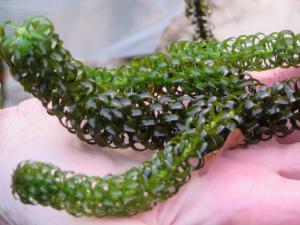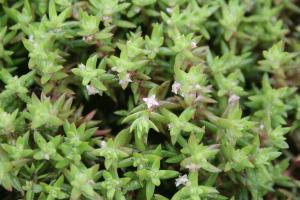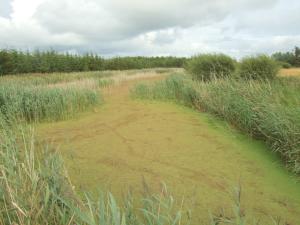Invasive non-native aquatic plants
Ponds can create a wonderful feature in your garden and are often a haven for wildlife. However, if not cared for properly, some pond plants can take over your pond. Getting rid of some of the worst non-native invasive species can take some time and a number of growing seasons.
Controlling invasive non-native aquatic plants
Take out all parts of the plant. Do not break them into small pieces, as this can help them spread.
Regularly check for and remove re-growth. This will help to keep these plants under control or get rid of them.
Report
If you find an invasive non-native plant in your pond or elsewhere you can report it by using the CEDaR Online Recording tool.
This helps scientists understand the distribution and spread of invasive non-native species
Act quickly
If you find an invasive non-native plant and want to remove it do not wait a few weeks or months. This could let the plant spread and become better established.
Remove every last bit
Most invasive non-native species can re-grow from tiny pieces. Try to remove every last bit and make sure to check for re-growth in the following season. Remove new plants as necessary.
Time your work
Problem plants can be pulled out at anytime. Big clear-outs should be done in autumn when they will cause the least disturbance to your pond and wildlife.
Clean your kit
Make sure to clean your footwear and equipment when removing unwanted plants. This helps to stop tiny pieces being carried on them that may re-grow.
Do not spread plants with your waste water
Waste pond water should be emptied away from streams, rivers, ponds, lakes, loughs and ditches, or drains that flow into them.
Instead, use the excess water on the lawn or to water plants in your garden. Avoid damp areas of your garden as some of these plants grow if the soil is too wet.
Protect pond life
Before disposing plants, leave them for a few hours beside the pond, so that invertebrates and animals can return to the pond.
Disposing of pond plants
You should:
- always dispose of plants and pond material by composting them or using your local green waste
- never place them in a nearby pond, waterway or in the wild - this could be illegal and the plants could damage the environment
- not give unwanted plants to other people either – this will spread the problem and harm their ponds
More techniques for dealing with particularly tricky species can be found at:
Examples of invasive non-native aquatic plants
Floating pennywort

Its scientific name is Hydrocotyle ranunculoides. It may be sold as water pennywort or simply, pennywort.
It has shiny, kidney-shaped leaves with crinkled edges. This weed was first brought into Northern Ireland as a plant for tropical aquariums and ponds. It has since escaped into the wild.
Floating pennywort cannot be sold, exchanged, cultivated or released into the environment.
In Northern Ireland, Floating pennywort has been identified as a Widely Spread Species.
Curly waterweed

Its scientific name is Lagarosiphon major. It may be sold wrongly as bunched Elodea Crispa oxygenating plants.
It has a long stem that is brittle and easily broken, helping it to spread. Its leaves that are strongly re-curved and are arranged in whorls or in a spiral. Most active growth is during winter and it can also spread easily from broken fragments.
It is illegal to intentionally keep, grow or cultivate it. Or, to transport it to, from or within Northern Ireland, use or exchange, or to release it into the environment.
Curly waterweed is a widely spread species.
New Zealand pigmyweed (Australian swamp stonecrop)

Its scientific name is Crassula helmsii but it is also sold wrongly as Crassula recurva, Tillaea recurva and Tillaea helmsii.
It is recognisable when growing at the water’s edge by its narrow, fleshy leaves. It grows both in and under the water, and on nearby land. It can regenerate from tiny fragments and therefore easily spreads to new areas. The plant grows on the muddy margins of ponds and it does not die back in winter.
Water fern (fairy fern)

Its scientific name is Azolla filiculoides.
This plant has tiny scale-like leaves no bigger than 2.5mm, forming small plants around 2.5cm long which can cluster to form a dense mat. It is green in summer but usually turns a distinctive red in autumn and winter. It is a small, free-floating water fern that grows and thrives in canals, ponds and sheltered aquatic habitats.
Always take care when buying new plants for your pond and make sure that water fern isn’t already present on the plant.
Parrot’s feather

Its scientific name is Myriophyllum aquaticum. It may also be sold as Myriophyllum brasiliense, Myriophyllum proserpinacoides, Brazilian water-milfoil, or simply as ‘oxygenator’.
It has bright green leaves, sometimes with a blue-grey sheen, that have a feathery appearance. It is a perennial plant that grows under water and has feathery shoots.
Parrot's feather cannot be sold, exchanged, cultivated or released into the environment.
In Northern Ireland, Parrot's feather has been identified as a Widely Spread Species.
Choosing the right plants for your pond
There are plenty of plants you can use for your pond. Which plants are best will depend on what kind of pond you have and where you are in the country. Talk to your pond plant retailer and ask them for advice on which species are most suitable and won't become invasive or escape into the wild.
Here are some suggestions for other native plants for your garden pond or aquarium.
Native marginal/emergent plants
- Flowering rush (Butomus umbellatus)
- Marsh marigold (Caltha palustris)
- Yellow flag iris (Iris pseudacorus)
- Bogbean (Menyanthes trifoliata)
- Ragged robin (Lychnis flos-cuculi)
- Water mint (Mentha aquatica)
- Marsh cinquefoil (Potentilla palustris)
- Brooklime (Veronica beccabunga)
- Water lobelia (Lobelia dortmanna)
- Arrowhead (Sagittaria sagittifolia)
- Common water-plantain (Alisma plantago-aquatica)
Native oxygenating plants
- Curled pondweed (Potamogeton crispus)
- Perfoliate pondweed (Potamogeton perfoliatus)
- Lesser pondweed (Potamogeton pusillus)
- Spike Water milfoil (Myriophyllum spicatum)
Native floating plants
- Yellow water lily (Nuphar lutea)
- White water lily (Nymphaea alba)
- Broad leaved pondweed (Potamogeton natans)
Importance of controlling invasive non-native aquatic species
It is important to stop the spread of invasive non-native species. They are an economic problem and a threat to the environment.
The biodiversity impacts are severe and growing. They can challenge the survival of the rarest species and damage some of the most sensitive ecosystems. Once a species has been introduced it can grow and spread.
If it becomes established in the wild, it can smother native plants, clog waterways and disrupt the navigation of boats. It can also interfere with recreational activities like fishing, cause flooding and remove oxygen from the water, which can harm fish.